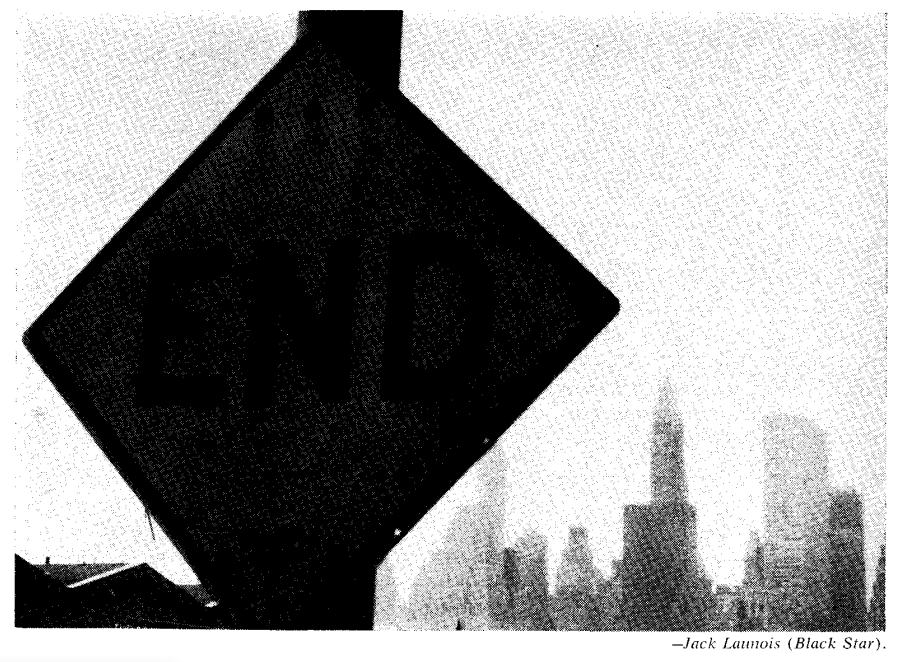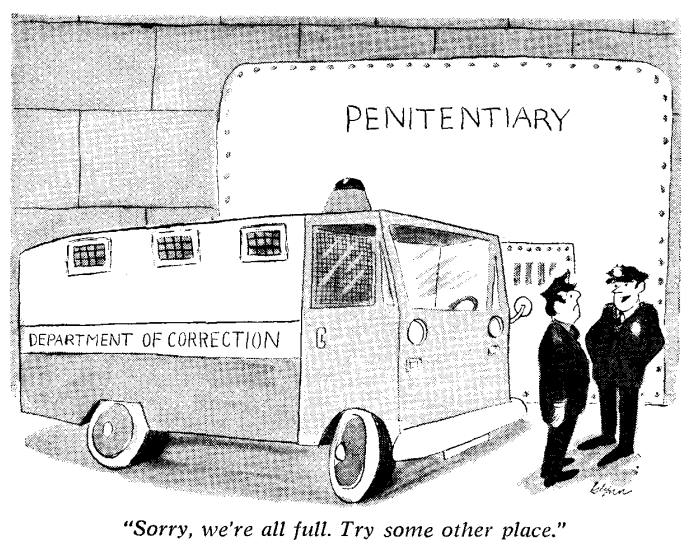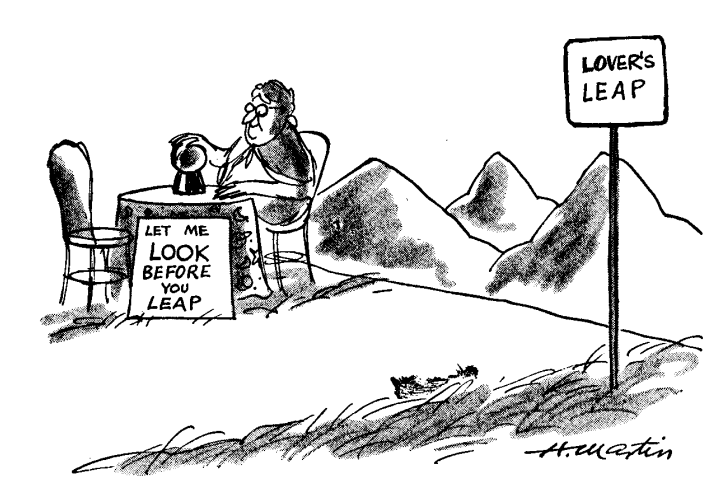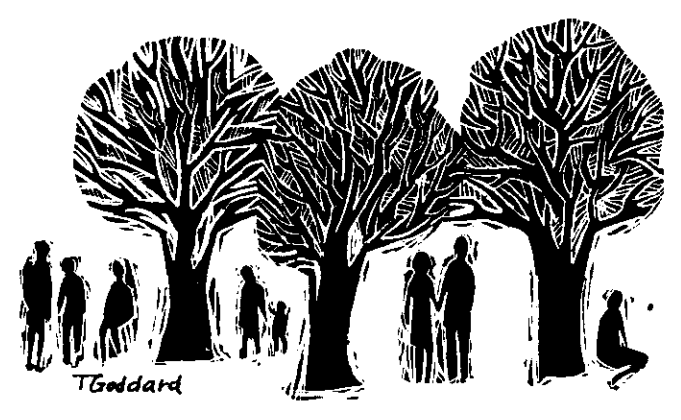And the California University Archive <harbor.klnpa.org/california/islandora/object/cali%3A939>
C .W. Griffin, Jr.
Frontier Freedoms and Space Age Cities
C. W. Griffin, Jr., is an engineer and professional planner. The above article is adapted from his book Frontier Freedoms and Space Age Cities, to be published by Pitman Publishing Corp.

Several years ago, in a magazine article ominously entitled “Is Your Right to Drive in Danger?” former Secretary of Commerce Luther Hodges denounced the masstransit boosters who want frontier Americans to stop driving their motorized steeds to work and ride the stagecoach with the dudes. "Fuzzy-minded theorists” reacting to spreading traffic jams, warned Mr. Hodges, have proposed imposition of rush-hour tolls to reduce traffic volume on major urban highways and a cutback in the urban freeway-building program. Such proposals, he said, threaten "our right to come and go as we please ... a heritage from frontier days.”
Nostalgia for frontier freedoms is manifest in almost every facet of American life—from the popularity of Wild West paperbacks, screenplays, and television shows to the economic “rugged individualism” extolled by businessmen living off cost-plus government contracts. The vicarious reliving of frontier days is both psychological escape and protest against the increasing frictions and collisions accompanying urban growth.
Many public issues reveal the depth of the pioneer strain. Obscured by campus protests and civil rights battles, less dramatic struggles to retain pioneer freedoms vent the irritations of urban Americans. In 1963, the citizens of Phoenix, Arizona, repealed a “socialistic” housing code that required slum landlords to provide toilets, running water, and other decadent luxuries for tenants. Blissfully oblivious of their downstream neighbors, the citizens of frontier-fabled St. Joseph, Missouri, fought for the right to discharge raw sewage into the Missouri River. After voting down two sewage-treatment bond issues, they abandoned their struggle only after the federal government instituted court action against their city. In June 1955, against the orders of the Los Angeles County Air Pollution Control District, citizens fought to retain their forefathers’ right to burn trash in backyard incinerators rather than accept the imposition of a municipal trash collection system. The exercise of this right released some 500 tons of contaminants into Los Angeles’s smog-polluted atmosphere every day. But that fact meant little compared with the historic freedom to burn trash.
Even more passionate in defending frontier freedoms are the gun buffs parroting the propaganda of the National Rifle Association and others who profit from gun traffic. At the primitive level of frontier civilization, vigilantism and widespread gun ownership were perhaps a partially rational adaptation to that lawless society. But today, in the tension-filled, crowded cities of modern America, resurgence of the gun mentality is a dangerous, infantile regression. Atavistic frontier outposts, such as Dallas, produce proportionately 100 to 200 times as many gun killings as civilized, gun-controlled nations such as Great Britain.
Instancing frontier freedoms in a less lethal but more visible way, the trash-littered streets of American cities immediately differentiate them from European cities. This still potent American talent for fouling the urban environment is merely a pallid vestige of the frontiersmen's talent. Everett Dick’s book The Sodhouse Frontier: 1854-1890 depicts the stark historical facts. In Wichita, Kansas, a typical frontier town, the ground at the hitching post was a stinking, fly-infested cesspool. Superimposed on this heady odor was the stench of outhouses, pigpens, and garbage tossed into the street or left at the doorstep by these pristine rugged individualists. The artfully blended aroma inspired the Wichita Eagle’s fastidious editor, a nineteenth-century precursor of the "fuzzy-minded theorists and wild-eyed planners” denounced by latter-day frontiersmen, to advocate controls that must have seemed socialistic: "heavy fines should be imposed on those who will throw slops, old meats, and decaying vegetable matter at their doors or on the street.”

The price paid for these filthy freedoms only began with the stench. Spread by disease-bearing flies that fed on the filth of outhouses and streets, typhoid epidemics sometimes swept through entire towns. Cholera, smallpox, and diphtheria were also epidemic. Primitive frontier technology made adequate sanitation difficult, and frontier medicine was just this side of witchcraft. But the mentally musclebound individualism of the frontier, with its contempt for public sanitation, extorted a graver price than was necessary. Even the almost instinctively visualized picture of vigorous, ruddy-faced pioneers was largely a myth. Disembarking from trains arriving in these frontier towns, visiting Easterners were often struck by the natives’ sallow complexions, a consequence of the prairie’s most common disease, the ague.
Town-building in frontier America often entailed an incredibly crude combination of greed and chicanery. Federal policy encouraged the mischievous work of land speculators (as it still does in subtler ways). To qualify for purchase of a 160-acre quarter section at a bargain price, a frontier land preemptor merely had to produce a witness to swear that the land was cultivated and improved with a "habitable dwelling” twelve feet square in plan. Among the ruses used to circumvent the law was a house on wheels (the archetypal trailer), rented for $5 a day and moved from claim to claim. Another was a house erected by railroad agents at the intersection of four lots, with one corner in each of the four 160-acre plots.
Railroad towns exhibited the "impatience, the speculative greed, and the lack of taste which characterized the founders,” according to planner John W. Reps. Existing towns, hoping to become important cities, fought fiercely for the railroads’ favor. But the railroads sometimes by-passed towns that refused to pay the required tribute and built their own. Railroad town-building was often ludicrous. Seeking access to newly opened markets west of the Mississippi, some railroad towns literally moved as track construction proceeded westward. One such town moved westward to exploit the location of Cheyenne, Wyoming, terminal depot for a rail line. According to a witness, a train arrived laden with framehouse lumber, furniture, paling, old tents, and other paraphernalia. A train guard called out, “Gentlemen, here’s Julesburg.”
In a letter dated March 13, 1878, preserved by the State Historical Society of Colorado, a commentator on the impending move of a town on the Denver and Rio Grande Railroad, wrote: “Soon Garland will be a thing of the past, and only battered oyster cans, cast-off clothing, old shoes, and debris generally will mark the site of where once stood a flourishing city, with its hotels, its stores, its theater comique.”
Even under the normal conditions of frontier town development, the transience of population worked against the cultivation of the civic spirit that inspires the stable populations of old European cities to preserve and enhance the beauty and amenity of their urban environment. Migration became a way of life for many Midwesterners. In his essay The Significance of the Frontier in American History, historian Frederick Jackson Turner tells of hundreds of men, less than fifty years old, who had resettled five or six times.
Capitalis ts instituted a civilizing process when they bought out the original settlers of small villages. Following traders, ranchers, miners, and farmers, this last wave of settlers transformed the frontier from villages of roughhewn loghouses to towns of respectable brick structures.
But the farmers’ practice of depleting the soil and moving on to exhaust new virgin tracts of prairie land nourished the frontier attitude of anarchic, antisocial individualism. With El Dorado always beckoning from beyond the western horizon, the migrant frontiersmen cared little for their present surroundings. Their attitude survives in today’s mobile Americans who have learned well their forefathers' lesson to value private goods higher than public goods.
What little justification was retained by the frontier ethic disappeared with the advent of the Industrial Revolution and the accelerated growth of American cities. The U.S. was not alone in creating hellish urban landscapes. The Coketowns of Dickens’s day, with their soot-blackened buildings, crowded tenements, smoke-poisoned air, and foul, gray rivers, were models for their American counterparts. But America’s frontier ethic, reinforcing the warped, utilitarian philosophy of the new industrialists, produced more uniformly desolate cities than those in Europe. The older European cities generally had a form and a tradition that resisted the depredations of the capitalists. But nineteenth-century Americans lacked the architectural splendors of Venice’s Piazza San Marco or London’s magnificent system of parks to inspire and educate them. They had no tradition of city planning or land-use control. And they were burdened with a city-hating intellectual history expressed most violently by Thomas Jefferson: "The mobs of great cities add just so much to the support of pure government as sores do to the strength of the human body.”
Flaunting the national contempt for urban values, we designed our cities as sensitively as barnyards. Riverfronts were sacrificed to factories, warehouses, and wharves, with no concession to the citizens’ need for recreational park sites. Sprawling railroad yards blighted vast areas adjacent to the central business districts. Sootbelching engines chugged through the densest urban districts, in contrast to the European example of banning railroads from the urban core. In New York’s most thickly settled slums, people were packed into six-story tenements at insect-scale densities unequaled in the Western world.
Yet, despite the tedious horror of these bleak monuments to greed, urban growth continued for decades without major breakdowns. White immigrants, sustained by the American dream, accepted their start in the urban slums. Successful urbanites, retreating before the advancing immigrants throughout most of our history, deserted the Commons in Boston, the Independence Hall area in Philadelphia, and Astor Place in New York. In Henry James's novel Washington Square (published in 1881), a character described the strategy: "At the end of three or four years we’ll move. That’s the way to live in New York. ... Then you always get the last thing.” Fueled by the immigrants’ hope of upward economic mobility and the middle class’s hope of outward physical mobility, the industrializing-urbanizing process kept going, despite the increasing frictions of accelerated growth.
.Joday, however, as hostility supplants hope in the central city ghettos, the old urbanizing mechanism threatens to break down. The earlier Italian, German, Irish, and Jewish newcomers never had to contend with the race prejudice that helps keep Negro migrants trapped in the ghettos. Like the earlier immigrants, urban Negroes occupy the lowest rung of the ladder to success. But for them the higher rungs have been sawed off, and the old American dream inspired by hope has yielded to escapist delusions inspired by dope.
Prosperous Americans’ dreams of continual escape, if not shattered, are fading. Slums, with their accompanying crime and other social ills, are spreading outward through the old suburbs and even into newer ones, continuing the historic trend. Current housing policies offer no hope of eliminating the slum racket. It remains the last pure vestige of primitive nineteenth-century capitalism, subsidized by ludicrously generous federal depreciation formulas, archaic local taxassessing policies, and slumlord-favoring condemnation pricing procedures. So long as they are profitable (and possibly even after they aren’t), slums will endure. Unlike the more civilized European nations that have eradicated slums, the United States has no national commitment to do so.
The white retreat from the spreading blight, through suburbia and ex-urbia, can’t continue indefinitely. The rising costs of land and public services and the ordeal of intra-urban transportation are curtailing the sprawling development that has spread recklessly over the countryside throughout the past two decades. The carving of white commuters’ freeways through black neighborhoods is meeting stronger resistance. Decaying central cities, spreading traffic jams, smog, polluted water, and vanishing recreational space have become the norm. Intensive planning and control on a regional basis, a subjugation of anarchic individual and local prerogatives to overall community interests offer the only hope of creating a decent urban environment, or even halting the deterioration of our present environment.

The idea of planning and conservation hits American traditions broadside. The successive waves of pioneers and farmers who rolled westward across the continent were as oblivious to their impact as the breakers that crash on the beach, shift the sands, and bend the coastline. Less innocent but more destructive, the industrial pirates who followed the pioneers plundered the resources and fouled the natural beauty of this continent, often to the applause of Congress. Not until the timber raiders had left trails of blackened woods and stripped hillsides, demonstrating to all but the willfully blind that our resources were not inexhaustible, did Congress reluctantly enact conservation legislation.
The most zealous nineteenth-century preachers of the frontier ethic glorified timber thieves as public benefactors persecuted by an oppressive government. In a speech delivered in 1852 to the U.S. House of Representatives, Henry Hastings Sibley, delegate from the Wisconsin Territory, denounced the federal trespass laws as "a disgrace to the country and to the nineteenth century.” In ringing phrases, Delegate Sibley extolled the virtuous victims of the law:
Especially is he pursued with unrelenting severity, who has dared to break the silence of the primeval forest by the blows of the American ax. The hardy lumberman who has penetrated to the remotest wilds of the Northwest, to drag from their recesses the materials for building up towns and cities in the great valley of the Mississippi, has been particularly marked out as a victim. After enduring all the privations and subjecting himself to all the perils incident to his vocation— when he has toiled for months to add by his honest labor to the comfort of his fellow men, and to the aggregate wealth of the nation, he finds himself suddenly in the clutches of the law for trespassing on the public domain. The proceeds of his long winter’s work are reft from him, and exposed to public sale for the benefit of his paternal government . . . and the object of this oppression and wrong is further harassed by vexatious law proceedings against him.
As evidence that praise for timber thieves was eminently respectable, Frederick Jackson Turner cites the lack of protest from other Congressmen and the subsequent success of Delegate Sibley. He became Minnesota’s first governor, a regent of its university, president of its historical society, and a doctor of laws from Princeton University—an exquisitely polished pillar of society. Commenting, Turner concludes, “Thus many of the pioneers, following the ideal of the right of the individual to rise, subordinated the rights of the nation and posterity to the desire that the country should be ‘developed’ and that the individual should advance with as little interference as possible. Squatter doctrines and individualism have left deep traces upon American conceptions.”
Today, well over half a century since Turner wrote this passage, those “traces” remain disgracefully deep. Contemporary industrial polluters, who recklessly poison the nation’s air and water, secretly agree with Delegate Sibley, but they can no longer openly defend lawbreaking without staining their image. The contemptuous, plundering spirit of nineteenthcentury capitalism lives on today in industrial polluters, highway-building lobbyists, land speculators, slumlords, and investment builders. Unlike the Swedes, who have accepted city planning and public land controls for centuries, we subsidize the destruction of our urban environment. That is why our disordered, traffic-plagued metropolises are such a contrast to Stockholm’s well-planned open spaces and its coordinated rapid transit system.

More than any major American city, Los Angeles illustrates the ludicrous conflict between frontier mythology and contemporary reality. The frontier mystique survives in almost pristine purity in America’s Southwest. As described by the late Christopher Rand in his book Los Angeles: The Ultimate City, the “short-range jet set,” shuttling between the southern California beaches and the Texas oil fields, lives a luxurious imitation of frontier life — camping, hunting, fishing, and ranching. Inspired by such political heroes as Governor Ronald Reagan and Arizona Senator Barry Goldwater, Los Angeles’s make-believe frontiersmen still preach laissez-faire, rugged individualism, despite their city's desperate economic dependence on federal arms contracts.
More ominous for their city’s future, these latter-day Babbitts cheer growth while still preaching the provincial frontier virtues that obstruct Los Angeles’s orderly transition into a supermetropolis. Before the year 2000, the Los Angeles region’s projected thirty-two-million population should overtake New York as the nation’s largest urbanized area. Yet, the transplanted, small-town Midwesterners who have dominated Los Angeles’s stream of immigrants have never really accepted their new home as a city.
Los Angeles’s physical form conveys the paradox of small-town people congregating in a big city. Its sprawling, unplanned development, a product of the city’s extreme laissez-faire frontier tradition, has spawned a host of social ills. Unlike New York police, patrolling beats on foot, Los Angeles’s officers patrol the city’s sprawling precincts in radio cars, remote and alienated from its citizens. With its characteristic contempt for public services, Los Angeles long ago taxed rail transit service to death to build competing highways. Having abandoned the rail network, which could have promoted orderly development and conserved open space, the city delivered itself almost totally to the cult of the automobile, thereby encouraging sprawl. Commuters forced to drive in the frenzied traffic made Los Angeles the photochemical smog capital of the world. The lack of public transportation also aggravates the isolation of the Watts ghetto, severely limiting access to the city’s widely scattered centers of employment.
Los Angeles’s obsession with the private side of life is expressed in other ways. Its zoning ordinances favor the single-family house as the most morally exalted form of human habitation, isolated from corrupting contact with residential apartments or commercial development. This policy promotes a more rigorous racial segregation than could possibly be achieved in a city such as New York, with its greater mingling of land uses and its greater reliance on public facilities.
The City of the Angels has squandered countless opportunities to build public parks and preserve open space; despite the unequaled resource of twenty-five square miles of wild land within its city limits, Los Angeles has no counterpart to New York’s Central Park or San Francisco’s equally remarkable Golden Gate Park.
The private developers’ bulldozed desecration of the Santa Monica Mountains recalls the depredations of the nineteenth-century miners, who washed away hillsides, silted streams, and ruined fertile valleys in their frantic search for gold. The conservationists’ failure to preserve these mountains for public use is another reminder of Los Angeles’s frontier ethos. Los Angeles land speculators pursue their frantic quest for private wealth in a desert of public poverty.
The throat-catching rhetoric of frontier freedom still stirs Americans, but at best the frontier ethic was only a partially valid response to the challenge of the wilderness. It has lasted at least a century past its time, and, viewed in retrospect, many of its values appear corrupt. Our nineteenthcentury tradition of destroying our own natural environment doubtless helps anesthetize us to American atrocities against nature in Vietnam, where massive jungle defoliation and crop poisoning may inflict permanent ecological damage. And our casual slaughter of Vietnamese villagers may be a contemporary version of frontier barbarism, which viewed the annihilation of animal herds and Indians as totally just sacrifices to the white man’s superior power.
Today, even in its less objectionable aspects, the anarchic individualism of the frontier is as outmoded as the prairie schooner. What has survived is not true rugged individualism, but its ugly residue—the obsession with private over public goods. To accommodate 100 million additional Americans destined to descend on our cities and suburbs over the next three decades, we must reject the insipid dream of a tamed frontier transformed into a semirural, suburban Arcadia. There is no place to hide from the stark realities of our crowded, city-centered society with its inevitable frictions, conflict, and turmoil. As pioneers on the urban frontier, can we outgrow the values of our rural ancestors and adapt to civilized urban life?
Letters to the Editor
Timeliness of Frontier Freedoms
As A Midwestern small-town dweller, I protest on two scores the assertion by C. W. Griffin, Jr., in "Frontier Freedoms and Space Age Cities” [SI?, Feb. 7] that Los Angeles is a prime example of a city that suffers from "the frontier mythology” of individualism or free enterprise because the source of L.A.’s difficulties, according to the author’s reasoning, is the Midwestern small town.
First, the frontier mythology, while weird and fantasy-laden, is not all that bad. The basic difficulty afflicting Los Angeles is not materially different from that experienced by many other metropolitan areas in our country, and has to do with ingestion. Our larger cities have been called upon to add great numbers of people of widely varying backgrounds to their populations before they were ready to assimilate these groups.
Second, historically speaking, individualism and free enterprise in our country have found visible expression in the development of factories and industries, nearly all of which have been located in our larger cities. On the other hand, the heart of the cooperative movement has been in the country.
It is generally true of our country’s western cities—with the possible exception of San Francisco—that they are spread out over more territory, and have more individual homes, especially ranchtype houses, than cities of the Eastern Seaboard. But this is not an illusion of freedom; it represents, at least to a degree, its achievement.
Avery D. Weage, Scribner, Neb.
C .W. Griffin, Jr., exaggerates the extent to which Americans romanticize the freedom, independence, and adventure of the frontier. In any case, such romanticization should be regarded as a symptom rather than a disease. A happily married man does not daydream about romantic love. Similarly, a man does not romanticize frontier freedoms unless he is suffering from a lack of personal autonomy. Mr. Griffin apparently would like to change people to make them lit the restrictive structure of society. Perhaps a better solution would be to change the structure of society so that it becomes possible to allow people some of the freedom and independence that they seem to crave. A society, after all, is supposed to be designed for the benefit of the peop'e that live in it, not the other way around.
Griffin would put the blame for our environmental problems on excessive individual freedoms. Actually, most of the problems are direct or indirect results of the activities of large organizations—corporations and governments. It is these organizations, after all, that control the structure and development of society. Perhaps the most unfortunate thing that has ever happened to individual liberty was its being used as an excuse for the misdeeds of huge corporations. Now the evils perpetrated by these highly collectivist organizations are blamed on "individual liberty.”
Theodore J. Kaczynski, Lombard, Ill.
